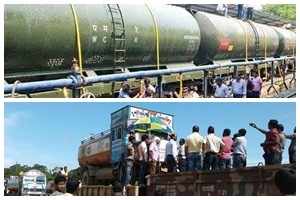Suresh Prabhu-led Indian Railways is increasingly emerging as a force for crisis and disaster relief management across the country. The vast reach of the Indian Railways network means that trains can be used to both mitigate and prevent major problems such as short supply of food, water and fuel. In this year itself, there have been multiple examples of the Railway Ministry stepping in to ensure speedy help and cater better to the needs of people. This is not to say that Indian Railways has traditionally not always served this function. However, there is a notable increase in its capacity to deliver and the focus required for it to do so. Here are four major initiatives that Indian Railways has undertaken this year:
Tripura fuel crisis:
One of the most recent examples of the crucial role played by Indian Railways is the way it helped deal with Tripura’s fuel crisis situation. For the first time in the history of North-East India, Indian Railways recently started a RoRo (Roll On Roll Off) service to transport fuel to the state. The need arose after petrol prices skyrocketed to levels of over Rs 300 per litre. Not just petrol, diesel prices had hit Rs 150 per litre and cooking gas was also very costly. Kilometre long lines at petrol pumps were common sights in the state. The situation was a result of road connectivity to Tripura being severely affected due to rains.
At this juncture, to reduce the demand-supply gap, Railways sent flat-wagon goods train with loaded tanker trucks from Assam to Churaibari in Tripura. PranavJyoti Sharma, Chief Public Relations Officer at North-East Frontier Railway told FE Online, “Earlier railway connectivity to North-East was a big problem, but now with Tripura being connected, Indian Railways has been able to provide timely aid to solve the crisis.” “IOC has given 2 lakh 36 thousand litres of HSD (High-Speed Diesel), 7*12 metric tonnes of LPG, 12,000 litres of motor spirit (petrol) and 48,000 litres of SKO (Superior Kerosene Oil),” he said when the first train was rolled out.
Also read: Bogibeel, India’s longest rail-cum-road bridge in Northeast, to be completed by 2018; here’s why it’s special
Food grains crisis in Northeast:
Not just fuel, Railways also sent a massive supply of food grains to the North-East. NH-8 (connects Assam with Tripura) and NH-2 (connects Mizoram, Manipur and Nagaland with the rest of India) was affected due to floods in Assam. This led to a severe food crisis situation in the North-East states. Northern Railways, which normally supplies rakes to FCI (Food Corporation of India) for normal transportation of food to these states, then cancelled some passenger trains to keep tracks free and facilitate the speedy transportation of additional food grains.
“See, in the normal course states here take a stock of their food grain supply, inform FCI of their requirements, and FCI in turn, asks for rakes from Indian Railways to meet the demand of North-East states. This is a weekly activity. In that sense, we also prevent a crisis from occurring. However, in this case, floods led to the supply diminishing faster as the road route was blocked. Indian Railways then deployed more trains to make sure that the food supply can be enhanced in line with the demand,” explained PranavJyoti Sharma.
Latur water crisis:
Maharashtra’s Latur district was badly affected due severe drought in the state, earlier this year. Acting as a saviour, Indian Railways sent water trains, or Jaldoot as they were called, to Latur. The government picked Miraj, Sangli, which is 342 km from Latur — the longest distance for a water train in India — to supply water. “A total of 26 crore litres of water was transported, and the arrangements were monitored by Railway Minister Suresh Prabhu and Maharashtra CM Devendra Fadnavis. Jaldoot did a total 111 trips to Latur,” said Anil Kumar, Senior PRO of Central Railway.
Also read: Antyodaya Express: Indian Railways set to roll out new train for unreserved class; here are the details
Started in April this year, Jaldoot trains played a crucial role in mitigating the water crisis of the parched district. The first train, with ten wagons of 5 lakh litres water capacity, started on April 11. From April 19 onwards the unloading capacity was increased by the district administration of Railways, and the Railways started sending 50 wagon trains with a total of 25 lakh litres of water. To carry water, Railway wagons were steam-cleaned, then cleaned with chemicals, scrubbed, and finally washed with high-pressure water jets. At Latur, initially, rubber pipes were used empty the water from wagons into an 850-m-long RCC pipeline. This pipeline led into a well nearby. Later more pipelines were laid by the government to expedite the process.
“On August 6, the district administration informed us that they would not require any more water. And so the service was stopped,” Kumar told FE Online. At a time when Maharashtra was reeling under the harsh drought, the importance of the continuous trips by Jaldoot can not be overstated.
IRCTC help for flood-hit states:
With Assam being hit by floods, IRCTC recently sent around 3,200 ready-to-eat food packets to the state. This was a first for IRCTC, given its recent tie-up with DRDO on ready-to-eat meals technology.
Beas bags award for Indian Railways’ cleanest station: Don’t miss these images!
In the past, Indian Railways has provided ‘Rail Neer’, its brand of drinking water to places hit by natural calamities. Ved Prakash, Director Information & Publicity at Ministry of Railways gives details, saying, “We provided 3.66 lakh litre of water during the J&K floods. We also sent water to Nepal when it was hit by an earthquake. We are looking to provide relief in whatever way possible, to whichever part of the country.”
